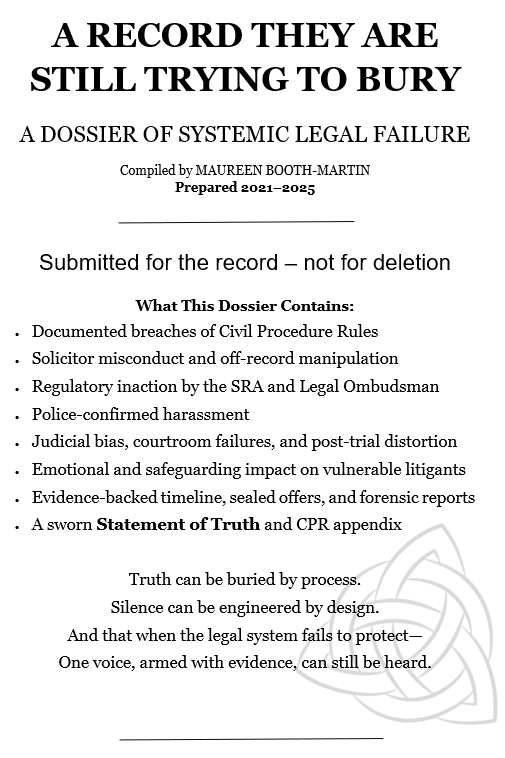A Record They Are Still Trying to Bury


January 2021 to April 2021
A Record They Are Still Trying to Bury
Foundations of Misconduct and Aggression
The Early Tactics of the Defence Solicitor
and the
Targeting of a Litigant in Person
A Dossier of Systemic Legal Failure
From the moment the defence firm entered the case on 12 January 2021, the tone shifted.
What might have been a path to resolution veered immediately into legal hostility.
- From the outset, communication wasn’t cooperative—Communication became sharp, cold, and procedurally intimidating
- No effort was made to level the playing field for an unrepresented litigant
- Legal language was used not to clarify — but to confuse and discourage
- The presumption of bad faith saturated every reply
- Most troubling of all, they falsely implied that regulatory bodies had reviewed and dismissed the matter
This was untrue. No contact had occurred — let alone a formal inquiry.
The aim was clear: to close the door before anyone knocked.
This wasn’t a dispute over snagging.
It was a live safeguarding emergency:
- Gas leaks
- Carbon monoxide poisoning
- A cable fire within the cavity wall
- Unsafe structural works
Expert reports later clarified how serious the threats really were — dangers I hadn’t even known we were living with.
This wasn’t a neutral beginning.
It was a warning shot. And it set the tone for everything that followed.
CPR 35.6
Misrepresented Across Months, Amplified Across Harm
From April 2021 to January 2022, the defence solicitor persistently misrepresented CPR 35.6 — claiming I was responsible for paying expert fees triggered by questions from the defence.
- It began in April, when 35 “clarification” questions strayed beyond clarification — cross-examining the expert without proper procedural justification
- By May, pressure escalated. Both the defence and the solicitor retained to assist supported the misinterpretation — omitting the clause in CPR 35.6(2) that places liability on the party posing the questions.
- Despite no joint instruction, no court order, and case law affirming defence responsibility, I was compelled to pay my expert’s £1,305 — plus additional costs to the solicitor who advised me off-record.
This wasn’t confusion.
It was coordinated distortion.
And it left a self-funded litigant footing a bill that never belonged to her.
April 2021 – CPR Distorted, Advice Introduced
On 27 April 2021 at 10:35am, the defence solicitor directly quoted CPR 35.6 to my expert in an email that sounded legally authoritative.
But the statement substituted legal fact with legal-sounding fiction.
It intentionally omitted the critical provision under CPR 35.6(2), which states that the party asking the questions — not the one instructing the expert — is responsible for the resulting fees.
By selectively quoting the rule while disguising the omission with a disclaimer about future court discretion, the solicitor created a veneer of neutrality.
But in context, the tactic applied pressure, fostered confusion, and shifted blame onto an unrepresented litigant who had followed correct procedure.
The impact was immediate and layered:
- Financial pressure placed on me to cover costs that weren’t mine
- Expert confusion, as legal clarity gave way to legal ambiguity
- False legitimacy, allowing a procedural breach to masquerade as professional conduct
This wasn’t a lapse in interpretation.
It was a sustained misuse of process — engineered to mislead, burden, and disadvantage.
June 2021
Harassment, Bombardment,
&
Breakdown in Legal Protections
How psychological pressure collided with procedural uncertainty — and where support began to falter.
From January to April, I received a continuous stream of adversarial correspondence from the defence solicitor.
Emails and formal letters arrived in overwhelming tone and volume.
On 21–22 June, the pressure surged
22 phone calls in under eight hours (15 preserved), with prolonged ringing that forced me to disconnect my landline — placing me at risk due to pre-existing medical needs.
- The defence solicitor framed my Particulars of Claim as “wholly inadequate,” cited ADR failure, and threatened cost sanctions and procedural penalties — despite ADR not being compulsory in small claims.
- He falsely accused me of obstructing expert replies under CPR 35.6, while omitting that proceedings had not yet been issued and the rule did not yet apply.
- His tone shifted from aggressive to personal — claiming I had “unlawfully” instructed the expert not to respond, had “pretended” delays were his fault, and was “playing the litigant in person card.”
- In writing, he repeatedly misrepresented my legal obligations, framed “non-cooperation” as tactical evasion, and warned of Unless Orders, claim strikeout, and cost consequences.
- I reached out to the solicitor I had engaged, reporting both procedural confusion and psychological impact.
- The solicitor involved in my case acknowledged the defence’s tone as “patronising and pedantic,” and confirmed the harassment was “not normal or necessary.”
- Though she initially suggested the behaviour could warrant a regulatory complaint, she instead advised a conciliatory tone and offered off-record assistance via fixed fee — without challenging the misuse of CPRs or offering safeguarding clarity.
“He is bullying you... You only do what the court tells you, not what he tells you.” — Support organisation, 22 June 2021
Why This Month Matters
June wasn’t just procedural. It was psychological.
What unfolded was a coordinated pressure campaign that blurred legal lines, misused CPRs pre-issue, and leveraged fear to coerce early concessions.
The solicitor hired to bring clarity instead imposed terms — subtly echoing the defence’s dominance.
This month became the bridge between formal abuse of process and emotional destabilisation.
Without pause, it fed directly into July’s solicitor missteps — turning an already unequal process into outright imbalance of power.
Police Involvement – Harassment Confirmed
Following the sustained campaign of pressure — calls, threats, procedural accusations — the matter was referred by one regional police force to another, where the solicitor resided.
- The originating force formally recorded the behaviour as Malicious Communications
- Upon review of emails, voicemails, and call logs, the receiving force upgraded the matter to Harassment within 12 hours
- The behaviour met the legal threshold for criminal concern — credible, patterned, distressing
- Though police offered to issue a Word of Advice in person, I declined — fearing further retaliation not only from the solicitor’s client, but from his wider professional and personal network
- The harassment had already disrupted our home environment: multiple calls in a single day forced me to disconnect our landline — temporarily disabling my emergency medical alarm and leaving us without access to a critical safety measure
- At the time, I was already in a state of emotional exhaustion and hypervigilance
This wasn’t overreaction.
It was a recognised safeguarding breach.
The breach was logged.
But July to September didn’t bring repair.
They brought rehearsal — of harm, of silence, of control.
It was a recognised safeguarding breach.
This wasn’t the end of the harm.
It was the moment the system looked away
and expected me to carry the weight.
The safeguarding breach was confirmed.
But the consequences were already leaking through the cracks.
What followed wasn’t resolution.
It was pressure. - It was erosion.
It was the beginning of collapse.
The escalation was next. And the silence was no longer neutral.
Design & Copyright Owner Maureen Booth-Martin (MBM) © All rights reserved




